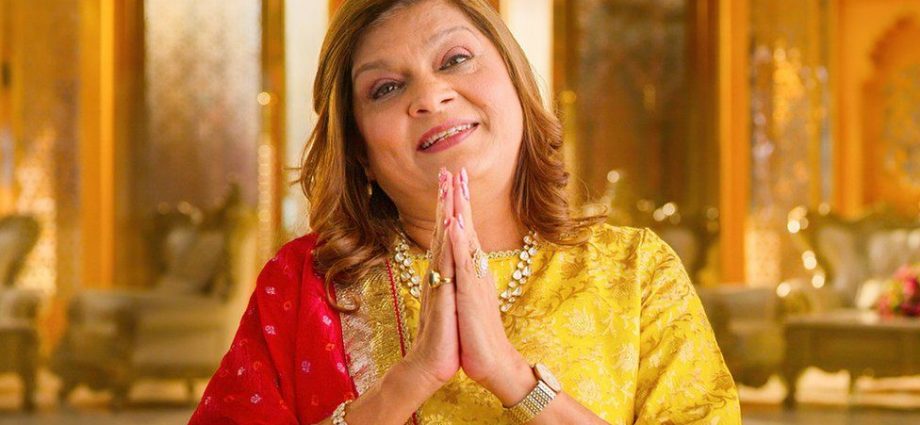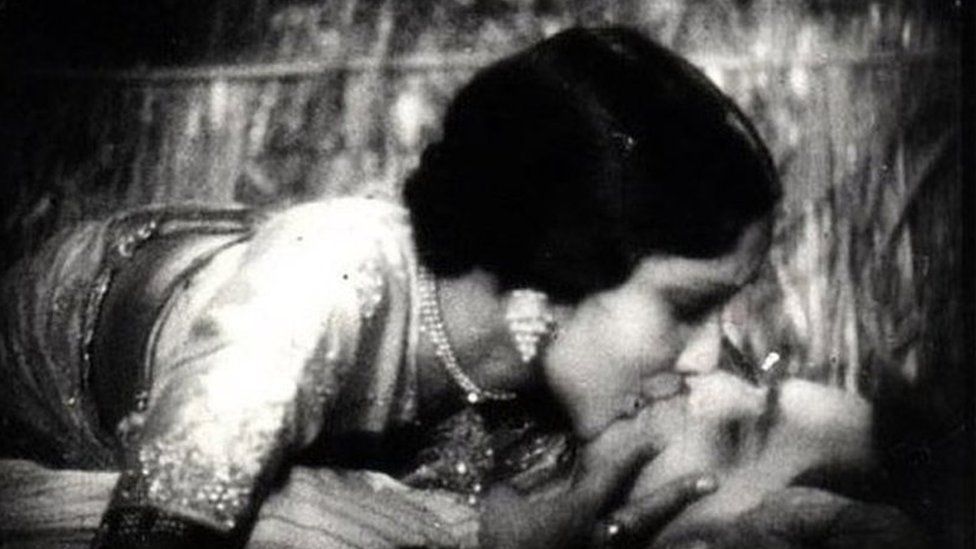
When a beautiful princess leaned over and tried to resuscitate her comatose lover with a kiss, she made cinematic history.
The kiss – from the 1933 film Karma – featuring real-life couple Devika Rani and Himanshu Rai – has long been written about as the first-ever Bollywood film to have a lip lock and “Bollywood’s longest kiss ever”. Apparently, neither is true.
The press at the time reported that the kiss was more than four minutes long, and the couple exchanging it on screen have been the subject of much myth-making in India ever since.
Rai and Rani went on to set up Bombay Talkies, India’s first professional film studio, in 1934 which dominated the first decade of talking cinema in India and set trends, many of which are still followed to this day.
A 2020 book, which recently received the National Film Award for Best Book on Indian Cinema from the country’s president, tries to set the record straight on the kiss and the tumultuous lives of the couple.
“The film was made at a time when Rai and Rani had just been married, they were still very much in love, so if passionate kisses were exchanged on screen, it was not a surprise,” says Kishwar Desai, author of The Longest Kiss: The Life and Times of Devika Rani.
Also, she says, “it was not unusual” for Indian cinema at the time to have a kissing scene as India was still ruled by the British and many of the films were made for a Western audience and some of them in the late 1920s and 1930s featured kisses.
Karma, like a lot of the cinema of the time, was steeped in “exotic orientalism”.
Described as “a love drama”, the 63-minute film was directed by British filmmaker JL Freer Hunt and boasted that it “featured actual royal palaces and scenes of oriental splendour”.
It was packed with clichés the West liked – the Indian royalty, a tiger hunt, mating cobras and a snake charmer.
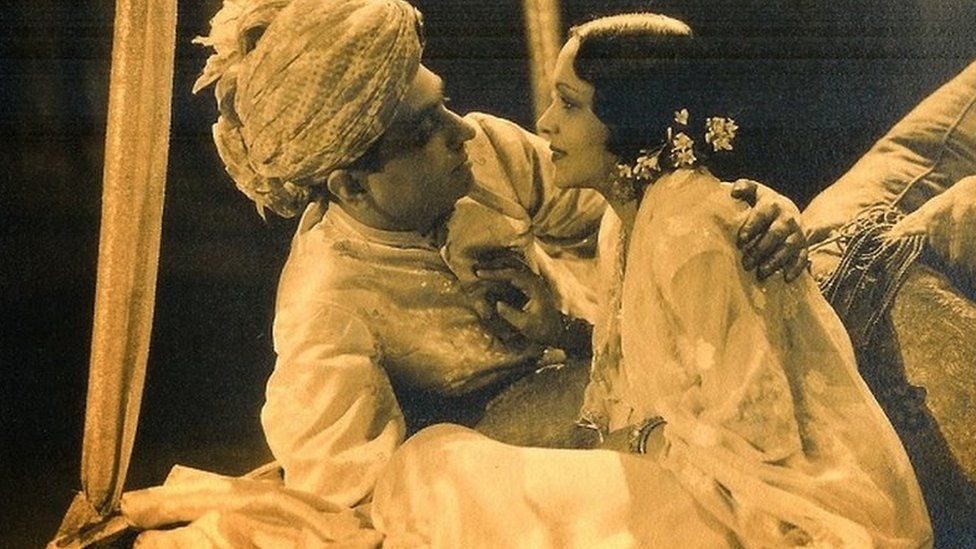
The kiss takes place almost at the end of the film as the desperate princess kisses the prince in a bid to revive him as he lays unconscious, bitten by a cobra.
“The myth is that it’s over four minutes long but that is not true,” Ms Desai says. “The kiss is obviously not the longest ever in a Bollywood film. To begin with it was not one kiss, it was a series of kisses. If you time it, it couldn’t probably cross two minutes.”
And the kiss was not a selling point of the film at the time, she says, adding that “it became a popular myth much later, most likely created by the press”.
Public displays of affection on and off screen have been largely taboo in India for decades – though cinematic depictions have got bolder in recent years.
In 2007, protests broke out after Hollywood actor Richard Gere kissed Bollywood actress Shilpa Shetty at a charity event in Delhi. Protesters burned effigies of the actor, claiming that he had insulted Indian culture.
In another incident a couple of years later, a young married couple in Delhi were charged with obscenity for kissing in public.
The film censor board also keeps a keen eye on anything that’s even slightly risqué – until some years ago, kisses were depicted by flowers brushing against each other and passion was expressed by a cup of milky coffee frothing over.
So, Karma stands out just because of the fact that a film made such a long while back featured a kiss.
The film though was a flop.
“The actress singing in an operatic style was not really meant for the Indian masses who didn’t like it much,” Ms Desai says.
But, she adds, the intention behind making this film was not its popularity but to use it “as a showpiece to tell the world that they could make cinema for the world stage from Bombay”.
“Himanshu Rai was already a success in Europe where he was considered a rising star. But he was an astute businessman, he was already thinking about setting up a studio in Bombay [now Mumbai], and by making a film like Karma, he was trying to send a message that he could make a film which would be equivalent to a Hollywood film.”
This, she says, was necessary as the prospective investors were British or members of the affluent Parsi community who were very Western in their outlook.
And that’s where Rani’s presence helped. The great-niece of Nobel laureate Rabindranath Tagore, she had been schooled in England from the age of nine and “was cast in the Western mould and was cosmopolitan”.
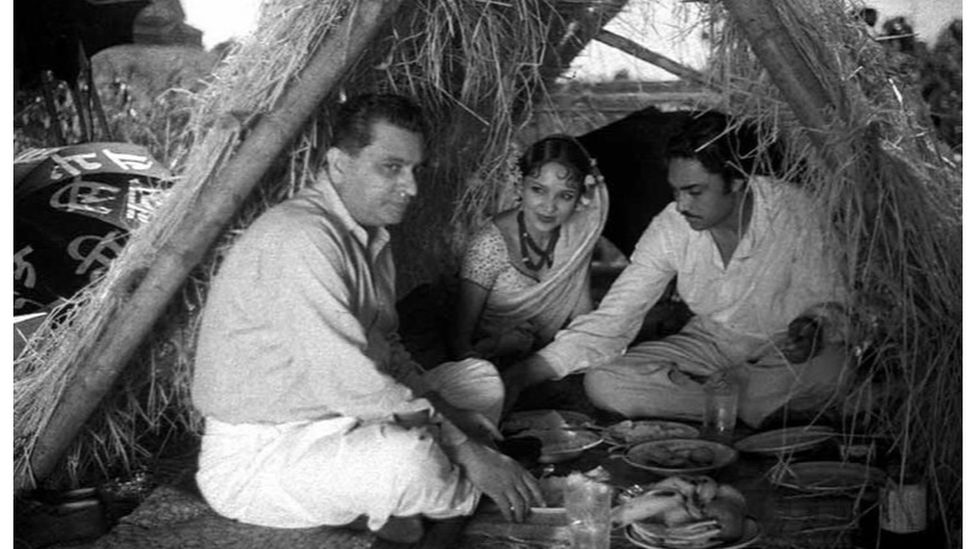
In her book, Ms Desai writes that Karma opened with great style at the Marble Arch theatre in London, where the show was attended by several prominent members of the British aristocracy amid rumours that King George V and Queen Mary would attend too.
The film got rave reviews, Ms Desai says, especially for Devika Rani, with “critics impressed by her beauty and diction”.
One newspaper wrote that “it would be difficult to find anyone lovelier than her” while another raved about “her lovely features and lustrous eyes and graceful movements”.
The film catapulted the actress into a league of her own, turning her into “India’s only internationally-renowned star, who was being wooed by Hollywood and European cinema”.
But she returned with Rai to Mumbai to set up India’s first professional studio, “where she got really busy working hard”.
She starred in over a dozen films and had a successful on-screen pairing with legendary actor Ashok Kumar, working in a number of hit films, including Achhut Kanya (The untouchable girl), where she played a low-caste woman in love with an upper-caste man.
Talented and beautiful, Rani ruled the hearts of her fans and was dubbed “the First Lady of Indian cinema”. But her relationship with Rai soon began to unravel.
“She was working very hard and was not credited enough. Her relationship with Rai also soured when she discovered that he was married before and had a daughter,” Ms Desai says.
In letters to her second husband – Russian artist Svetoslav Roerich – whom she met and married a few years after Rai’s death, Devika Rani documented how he had started treating her badly, forcing her to work hard even when she was sick with a high temperature.
On one occasion, she wrote that he hit her with a script until she fell on the floor bleeding.
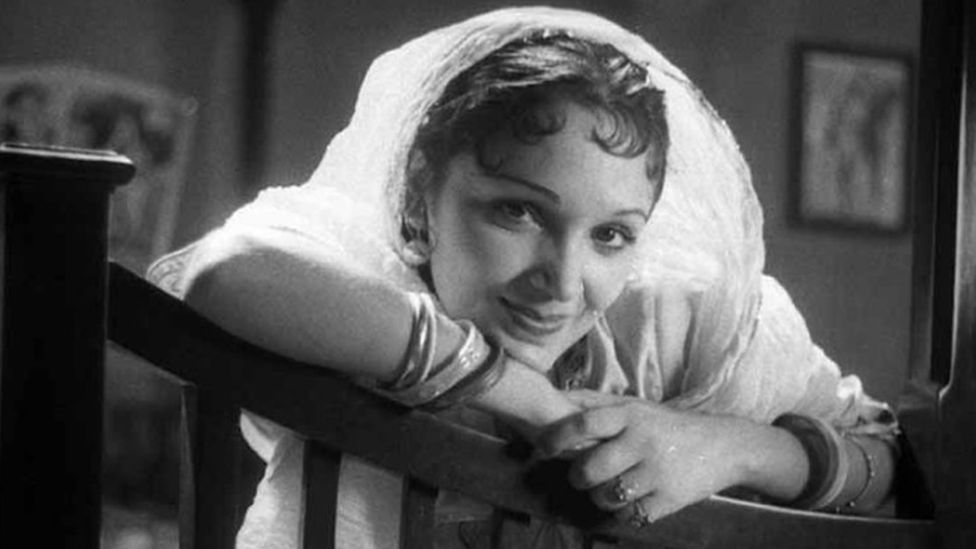
The fissures in their relationship were there for all to see when in 1936 she ran away with a co-star but despite that, Ms Desai says, “she was welcomed back with open arms – and that’s because she truly was irreplaceable”.
The outbreak of World War Two severely impacted the Bombay Talkies as its entire German staff was detained and put in camps by India’s British rulers.
After Rai suffered a nervous breakdown and died in 1940, Devika Rani ran the studio as a producer, giving breaks to legendary actors such as Madhubala and Dilip Kumar, and delivering many superhit films.
But in 1945, she sold her shares, married Svetoslav Roerich and moved to the Himalayan state of Himachal Pradesh, and eventually relocated to Bangalore. She lived there until her death in 1994, a year after her husband died.
“After her marriage to Roerich, she probably got the life she wanted,” Ms Desai says.
Bombay Talkies, however, didn’t survive long once Rani left – “it limped along for a few years before folding up in 1954”, she adds.

Read more India stories from the BBC:

-
-
1 September 2022

-

